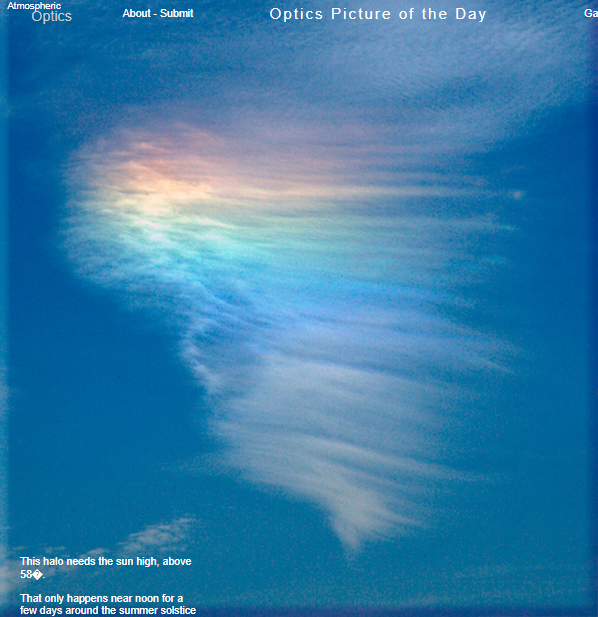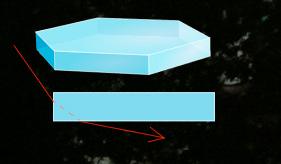Welsh Rarity
Welsh Rarity: A Stunning Atmospheric Phenomenon
Have you ever witnessed a breathtaking atmospheric phenomenon known as the circumhorizon arc? This elusive optical display is a true rarity, captivating the hearts of sky enthusiasts and photographers alike. One such remarkable instance was captured by Jon Trew in Barry, Glamorgan, South Wales on the 21st of June. Let's delve deeper into this mesmerizing event and explore the intricacies that make it so extraordinary.
The Elusive Nature of the Circumhorizon Arc
What sets the circumhorizon arc apart is its remarkable scarcity. To witness this awe-inspiring phenomenon, one must be in a location where the sun reaches an altitude of at least 58 degrees. In the United Kingdom and similar European latitudes, this only occurs for a few days around the summer solstice. As a result, the halo often appears hugging the horizon, making it challenging to observe due to the prevalence of cloudy skies.
Imagine the anticipation of waiting for just a glimpse of this celestial spectacle. Glancing through the window, hoping for a tiny fragment of the circumhorizon arc to grace the southern sky. The sun shines brightly, with scattered cirrus clouds dotting the expanse, but alas, the horizon is obscured by woolly cumulus clouds. Perhaps tomorrow, or maybe next year's solstice, one might be fortunate enough to witness this rare and cherished sight.
A More Frequent Spectacle in Other Regions
Our friends across the Atlantic and in more southerly regions have reason to rejoice. With higher sun altitudes and clearer skies, they are blessed with a more frequent occurrence of the circumhorizon arc. By diligently scanning the heavens, they may be fortunate enough to witness this captivating phenomenon several times each year.
The Enormous Size and Vibrant Colors
When the circumhorizon arc manifests in its entirety, it astounds observers with its sheer size. Extending two outstretched hand spans below the sun, this stunning halo partially encircles the horizon. The vibrant colors that adorn the arc are a result of the interaction between horizontally aligned hexagonal plate ice crystals and the sunlight.
Unveiling the Science Behind the Phenomenon
The primary agents responsible for creating the circumhorizon arc are hexagonal plate ice crystals found within high and freezing cirrus clouds. These ice crystals act as prisms, refracting light as it enters a vertical side face and exits through the base. The refraction, equivalent to a 90-degree angle, causes the colors to disperse widely and appear pure and separated.
A Glimpse into Jon Trew's Capture
Jon Trew's remarkable photograph captured the circumhorizon arc when the sun was nearly 60 degrees above the horizon. The ice crystals that formed the arc were likely present in a band of cirrus clouds that had developed and spread from an airplane contrail. This unique perspective adds an extra layer of fascination to an already extraordinary phenomenon.
In conclusion, the circumhorizon arc is an atmospheric rarity that enchants those fortunate enough to witness it. With its fleeting appearances and breathtaking size, this optical marvel leaves spectators in awe of nature's wonders. Whether you're in Wales, Europe, or beyond, keep your eyes to the sky and hope for a glimpse of this elusive beauty.

Welsh Rarity
Jon Trew caught this circumhorizon arc fragment at Barry, Glamorgan, South Wales on 21st June. Top picture Nikon, lower iPhone.
What is so very rare and unusual about it? Read below.
Image ©Jon Trew, shown with permission.
This halo needs the sun high, above 58�.
That only happens near noon for a few days around the summer solstice In the UK and similar European latitudes.
Then the halo hugs the horizon and we must contend too with cloudy skies! As I write this at midday I keep glancing through the window to check the south for just a glimpse of just a tiny fragment of one. The sun shines strong and there is some cirrus but the horizon is congested with woolly cumulus. Wait, now the sun has faded - maybe tomorrow, maybe at next year�s solstice or the year after! They are a very rare and cherished sight here.
American and more southerly cousins be pleased for with your higher sun and clearer skies it is a much more frequent spectacle. With careful sky checking you might see it several times each year.
When complete the halo is huge. It is two outstretched hand spans below the sun and sweeps partly around the horizon.
Horizontally aligned hexagonal plate ice crystals in high and freezing cirrus are responsible. Light enters a vertical side face and exits the base. The refraction through the equivalent of a 90� gives the widely separated and pure colours.
The sun was almost 60� high when Jon Trew saw his fragment. The ice crystals appear to be in a band of cirrus that has developed and spread from an airplane contrail.

Note: this article has been automatically converted from the old site and may not appear as intended. You can find the original article here.
Reference Atmospheric Optics
If you use any of the definitions, information, or data presented on Atmospheric Optics, please copy the link or reference below to properly credit us as the reference source. Thank you!
-
<a href="https://atoptics.co.uk/blog/welsh-rarity/">Welsh Rarity</a>
-
"Welsh Rarity". Atmospheric Optics. Accessed on April 20, 2024. https://atoptics.co.uk/blog/welsh-rarity/.
-
"Welsh Rarity". Atmospheric Optics, https://atoptics.co.uk/blog/welsh-rarity/. Accessed 20 April, 2024
-
Welsh Rarity. Atmospheric Optics. Retrieved from https://atoptics.co.uk/blog/welsh-rarity/.